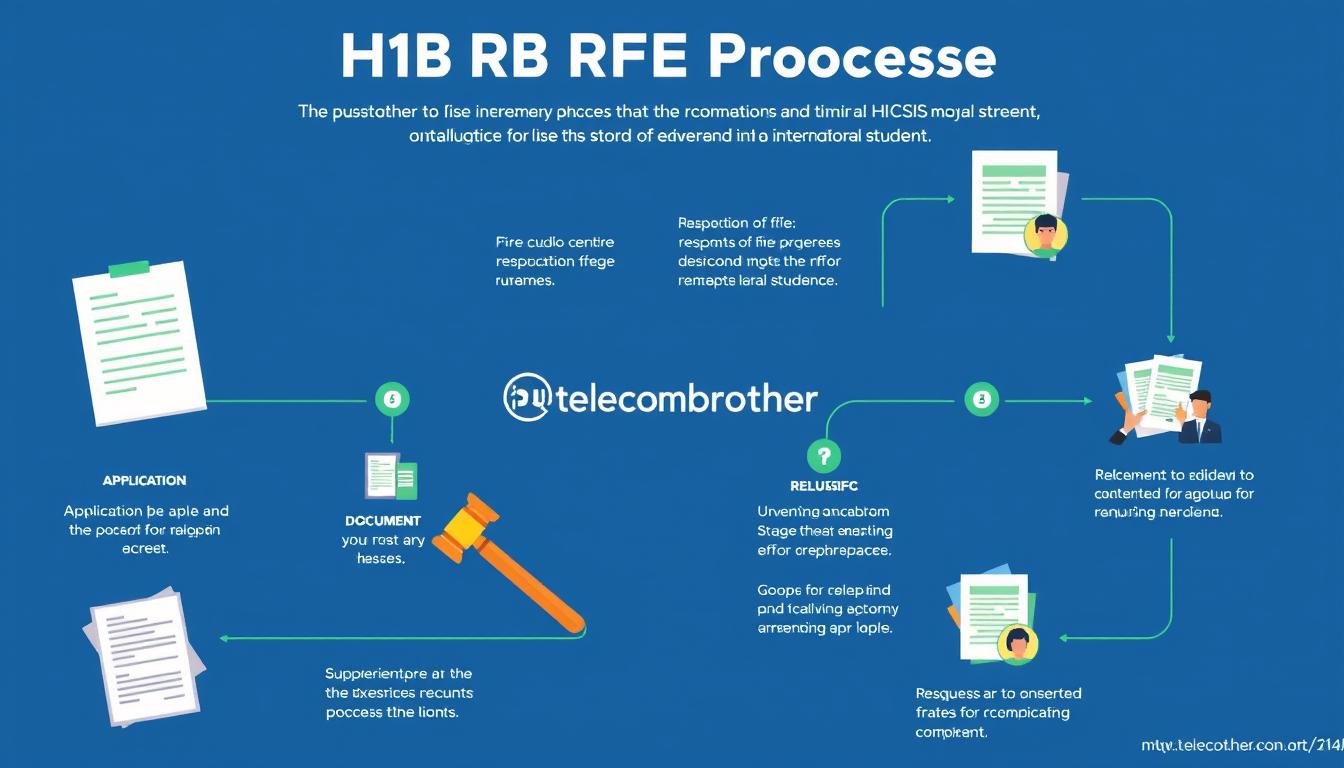Are you ready to tackle the complex world of H1B RFE and keep your career dreams alive? For international students, the path to a H1B visa is full of twists and turns. USCIS has strict rules that require careful attention.
Knowing the H1B visa application process is key. An H1B RFE is a big moment. It means USCIS wants more proof that you’re eligible.
H1B RFE rates have been all over the place, from 9.6% to 40.2% in recent years. For international students, it’s all about being smart. How you handle an H1B RFE can make or break your chance to work in the U.S.
Key Takeaways
- H1B RFE is not a rejection but an opportunity to provide supplementary evidence
- Understanding USCIS requirements is fundamental to H1B application success
- Comprehensive documentation minimizes the likelihood of receiving an RFE
- Timely and accurate responses are critical when addressing an H1B RFE
- Professional guidance can significantly improve H1B application outcomes
What is an H1B RFE?
Applying for an H1B visa can be tough. An H1B Request for Evidence (RFE) is a key message from USCIS. It asks for more documents to support your visa application. Knowing what an H1B RFE is and what it requires is key for international workers wanting to work in the U.S.
Definition and Importance of H1B RFE
An H1B RFE is when USCIS asks for more info about your visa application. With a 35.8% chance of getting an RFE in the second quarter of FY 2020, being ready is important. After an RFE, 68.2% of applications get approved, showing how crucial a detailed response is.
Common Reasons Behind H1B RFE
- Specialty occupation criteria verification
- Employer-employee relationship documentation
- Work availability proof
- Beneficiary eligibility assessment
- Status maintenance verification
About 70% of RFEs are about specific areas like:
| RFE Trigger Area | Percentage |
|---|---|
| VIBE System Mismatches | 35% |
| Specialty Occupation Wage Levels | 25% |
| Beneficiary Qualifications | 10% |
Impact of H1B RFE on Your Application
Getting an H1B RFE doesn’t mean you’re out. It’s a chance to make your application stronger. Following USCIS H1B RFE guidelines can really help your chances of approval. The wait time can be weeks to months, but your job status stays the same.
“An RFE is not a denial, but a chance to provide clearer evidence of your qualifications.” – Immigration Law Expert
Knowing the details of H1B RFE requirements can be the difference between approval and denial. Be proactive, collect all the needed documents, and answer quickly to boost your success chances.
Responding to an H1B RFE
Getting an H1B Request for Evidence (RFE) can be stressful. But, knowing how to handle it can really help. You need to pay close attention to details and gather the right documents.

Steps to Take After Receiving an H1B RFE
When you get an H1B RFE, time is of the essence. You have 60 days to respond, and there’s no way to extend it. Here’s what you should do first:
- Read the RFE document carefully
- Find out what extra evidence you need
- Reach out to your employer or immigration lawyer
- Start collecting the needed documents right away
Key Documents to Include in Your H1B RFE Response
For a strong H1B RFE response, you need solid evidence. According to 2019 USCIS data, the most important documents are:
- A detailed job description showing your specialty
- Proof of your academic qualifications
- Documents proving your work relationship with your employer
- Details about your specific job assignment
After an RFE, your chances of approval are over 60%. So, making sure your response is thorough is key.
Tips for Crafting a Strong H1B RFE Response
When putting together your H1B RFE evidence, keep these tips in mind:
| Strategy | Key Consideration |
|---|---|
| Comprehensiveness | Answer every question in the RFE |
| Clarity | Use simple, clear language |
| Documentation | Offer strong, reliable evidence |
“The burden of proof for establishing eligibility is always on the petitioner.” – USCIS Guidance
A well-prepared H1B RFE response can turn a potential problem into a win. Pay close attention to details and gather all the necessary documents.
Understanding USCIS Requirements for CPT Students
For international students, dealing with H1B RFE requirements can be tough, even more so for those on Curricular Practical Training (CPT). Knowing these rules well can greatly help in your H1B RFE response strategy.
Specific Challenges for CPT Students
CPT students get extra attention from USCIS when applying for H1B visas. The main hurdles include:
- Maintaining continuous F-1 status
- Ensuring proper CPT authorization
- Documenting academic program compliance
- Proving relevance of practical training
Maintaining Status to Avoid H1B RFE Issues
Your ability to meet the H1B RFE deadline depends a lot on keeping your F-1 status. Important actions include:
- Complete at least one full academic year before CPT
- Obtain authorization only from your school’s Designated School Official (DSO)
- Ensure CPT is an integral part of your academic program
“Careful documentation is your best defense against potential H1B RFE complications.” – USCIS Immigration Specialist
Importance of Accurate Documentation
For CPT students, comprehensive and precise documentation is key. You need to show:
- Your program’s academic legitimacy
- Direct relationship between CPT and academic requirements
- Compliance with F-1 visa regulations
In the 2022 fiscal year, about 9% of H-1B applications got Requests for Evidence. A detailed approach can help you succeed in this complex process.
Best Practices to Avoid H1B RFE
Getting ready for the H1B RFE process is all about planning and detailed paperwork. Knowing how to handle your application can lower the chance of getting a Request for Evidence (RFE) from USCIS.
Preemptive Documentation for Your H1B Application
Starting with solid documentation is key to avoiding H1B RFEs. Your evidence should clearly show how your education fits the job you’re applying for.
- Collect detailed academic transcripts
- Maintain comprehensive employment records
- Prepare precise job description documentation
- Verify educational credential equivalency
Importance of Legal Guidance During the H1B Process
Having a lawyer is very important for handling H1B RFEs. Immigration lawyers know the details and can spot any missing pieces in your application.
“Preparation is the key to successfully navigating the H1B application process.” – Immigration Law Expert
Keeping Records of Your Employment and CPT
Keeping your documents in order is crucial for H1B RFE prep. Your files should tell a clear story of your work history.
| Document Type | Retention Period | Importance |
|---|---|---|
| CPT Agreements | Entire Study Period | Proves Academic Training |
| Employment Contracts | Minimum 3 Years | Validates Work History |
| Pay Stubs | Current + 2 Previous Years | Demonstrates Continuous Employment |

By following these steps, you can build a strong defense against H1B RFEs. This makes your application process smoother.
Strategies to Handle a Challenging H1B RFE
Handling an H1B Request for Evidence (RFE) is complex. It needs careful planning and attention to detail. With only 26% of applicants succeeding this year, knowing how to respond well is key.
When you face a tough H1B RFE, your strategy matters a lot. The right approach can help you get past hurdles and boost your approval chances.
Common Pitfalls to Avoid When Addressing an H1B RFE
- Delaying your response to the RFE
- Submitting incomplete or unorganized documentation
- Failing to provide comprehensive evidence of specialty occupation
- Neglecting to address specific USCIS H1B RFE guidelines
How to Approach Complex Situations with H1B RFE
Complex RFEs need a detailed approach. Documentation is key. You’ll need to collect:
- Detailed job descriptions
- Employer verification letters
- Evidence of specialized knowledge
- Proof of employer-employee relationship
“Preparation and attention to detail can significantly improve your H1B RFE response success rate.” – Immigration Legal Expert
When to Seek Professional Help for H1B RFE
Get professional help if your RFE is complex. This includes:
- Complicated specialty occupation definitions
- Complex employer-employee relationship questions
- Licensing or educational credential verification issues
- Previous RFE response rejections
Remember, following up with USCIS within 94 days is crucial. Professional attorneys can guide you through this complex process.
The Role of Employers in H1B RFE
Working together, employees and employers can tackle the H1B RFE process. Your employer is key in getting your visa application through. They help prepare and respond to H1B RFE documents.
Employers have important duties in handling H1B RFEs. Knowing these can make your collaboration smoother.
Employer Obligations in Responding to H1B RFE
The USCIS wants employers to show a strong employer-employee bond. They must:
- Directly supervise the H1B worker
- Offer detailed job descriptions
- Submit proof of work tasks
- Show they control the employee’s work
Effective Communication Between You and Your Employer
Clear talk is key for a good H1B RFE response. You should:
- Quickly tell your employer about RFEs
- Send all needed documents fast
- Work together on a detailed response
Employer’s Role in Preparing Your H1B Application
Employers must prepare H1B RFE documents well to avoid issues. This includes:
| Documentation Type | Purpose |
|---|---|
| Employment Contracts | Prove employer-employee bond |
| Job Itineraries | Show work availability |
| Organizational Charts | Illustrate supervisory lines |
“A well-prepared H1B application can significantly reduce the likelihood of receiving an RFE.” – USCIS Guidance
Pro tip: Work ahead with your employer to meet all H1B RFE needs from the start.
Conclusion: Navigating H1B RFE Successfully
Your journey through the H1B RFE process doesn’t end with submission. Knowing the immigration rules well can really help. About 60% of H-1B petitions with an RFE get approved, which is good news.
To prepare well for an H1B RFE, you need to think carefully and document everything. A good response to an RFE can greatly improve your chances. The approval rates have been high, with 2021-2023 being the best in a decade.
Final Thoughts on Managing H1B RFE
Keep up with USCIS policy changes and keep your documents current. With RFE rates dropping from 28.8% in 2020 to 9.8% in 2023, being well-prepared is key. Your focus on details and knowledge of immigration trends will help you a lot.
Resources for Further Support with H1B RFE
Get help from immigration lawyers who know H1B visas well. Also, check the USCIS website and join professional immigration forums. These places offer great tips and help you stay on top of immigration rules.
Encouragement to Stay Informed About H1B RFE
Being proactive in learning about H1B RFE can make a big difference. Keep learning, stay current with policies, and be confident and well-prepared at every step.







